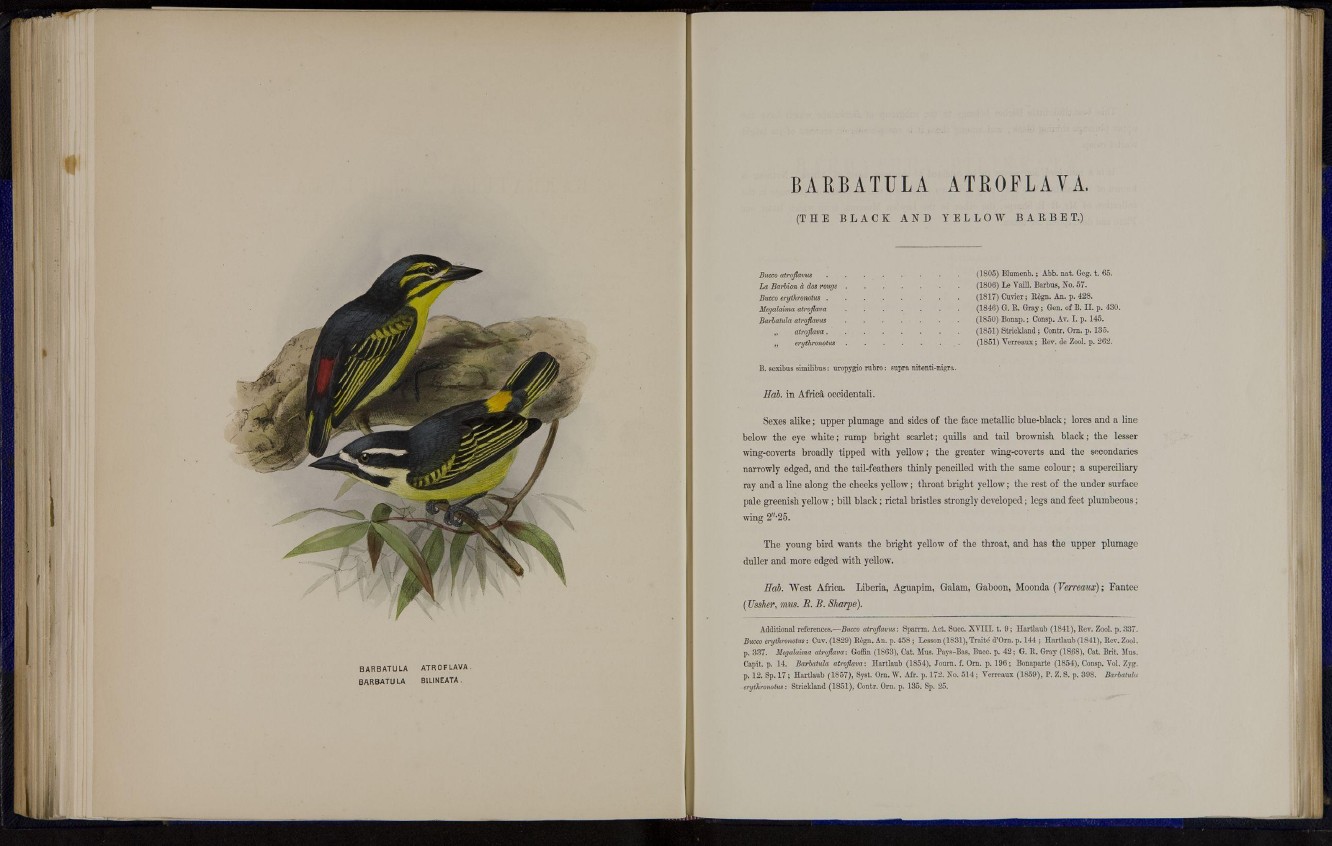
B A R B A T U L A ATROFLAVA.
( T H E B L A C K A N D Y E L L O W B A R B E T .)
Bucco atrqflavua (1805) Blumenb. ; Abb. nat. Geg. t. 65.
La Barbion à dos rouge (1806) Le Vaill. Barbus, No. 57.
Bucco eryihronotus (181") Cuvicr ; llègn. An. p. 428.
Megalaima atroflava . . . . . . . (1846) G. R. Gray ; Gen. of B. II. p. 430.
Barbalula atroflavus (1850) Bonap. ; Consp. Av. I. p. 145.
„ atroflava. (1851) Strickland ; Contr. Orn. p. 135.
„ eryihronotus (1851) Verreaux ; Rev. de Zool. p. 262.
B. sexibus similibus : uropygio rabro : supra nitenti-nigra.
Hah. in Africa occidentali.
Sexes alike ; upper plumage and sides of the face metallic blue-black ; lores and a line
below the eye white; rump bright scarlet; quills and tail brownish black; the lesser
wing-coverts broadly tipped with yellow ; the greater wing-coverts and the secondaries
narrowly edged, and the tail-feathers thinly pencilled with the same colour ; a superciliaryray
and a line along the cheeks yellow ; throat bright yellow ; the rest of the under surface
pale greenish yellow ; bill black ; rictal bristles strongly developed ; legs and feet plumbeous ;
wing 2"-25.
The young bird wants the bright yellow of the throat, and has the upper plumage
duller and more edged with yellow.
Eab. West Africa. Liberia, Aguapim, Galam, Gaboon, Moonda ( Verreaux) ; Fantee
( Ussher, mm. R. B. Sharpe).
Additional references.—Bucco atroflavus: Sparrm. Act. Suec. XVIII. t. 9 ; Hartlaub (1841), Rev. Zool. p. 337.
Bucco erythronotus : Cuv. (1829) Règn. An. p. 458 ; Lesson (1831), Traité d'Orn. p. 144 ; Hartlaub (1841), Rev. Zool.
p. 337. Megalaima atroflava: Goffin (1863), Cat. Mus. Pays-Bas, Bucc. p. 42 ; G. R. Gray (1868), Cat. Brit. Mus.
Capit. p. 14. Barbatula atroflava: Hartlaub (1854), Journ. f. Orn. p. 196; Bonaparte (1854), Consp. Vol. Zyg.
p. 12. Sp. 17 ; Hartlaub (1857), Syst. Orn. W. Afr. p. 172. No. 514 ; Verreaux (1859), P. Z. S. p. 398. Barbahda
eryihronotus: Strickland (1851), Contr. Orn. p. 135. Sp. 25.